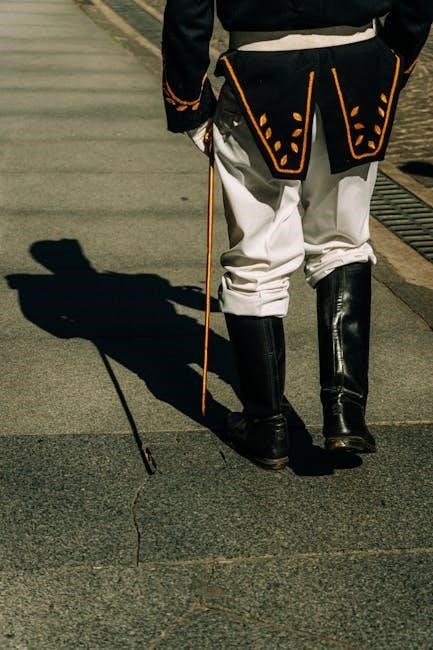Clipper guards are essential for achieving precise haircuts, preventing scalp irritation, and maintaining consistent styles․ They are versatile, fitting most clippers, and ideal for both home and professional use․
What Are Clipper Guards?
Clipper guards are plastic or metal attachments that fit onto hair clippers to control the length of hair being cut․ They act as a protective barrier, ensuring hair is trimmed to a specific length without cutting too short․ Guards are numbered (typically 0-8 or 10) to indicate the length of hair left, with lower numbers for shorter cuts and higher numbers for longer styles․ They are essential for achieving consistent, precise haircuts and preventing scalp irritation․
The Importance of Clipper Guards in Haircutting
Clipper guards are crucial for achieving precise, even haircuts․ They ensure consistent hair length, preventing uneven cuts and scalp irritation․ Guards allow for versatility in styling, from buzz cuts to fades, and are indispensable for both professional barbers and home users․ By using the right guard size, individuals can maintain their desired hairstyle with ease and confidence, making them an essential tool in haircutting․

Understanding Clipper Guard Sizes
Clipper guard sizes are numbered attachments determining hair length․ Sizes range from 0 to 8 or 10, correlating to specific measurements in mm or inches, ensuring precise cuts for various styles․
Standard Clipper Guard Numbering System
The standard clipper guard numbering system ranges from 0 to 8, with higher numbers indicating longer hair lengths․ Each guard size corresponds to specific measurements in millimeters and inches, ensuring consistency across different brands․ For example, a size 0 guard cuts extremely close, while a size 8 guard leaves about 1 inch of hair․ This system helps barbers and users achieve precise, uniform cuts, making it a fundamental tool in haircutting․
How Guard Sizes Correlate to Hair Length
Clipper guard sizes directly determine hair length, with lower numbers cutting closer to the scalp and higher numbers leaving more length․ For example, a size 0 cuts at 0․25mm, while a size 4 leaves 13mm of hair․ This precise correlation allows for consistent results, making it easy to achieve desired styles, from buzz cuts to longer layered looks, by selecting the appropriate guard size for the job․
Key Differences Between Clipper Guard Sizes
Clipper guard sizes vary significantly in the length of hair they leave․ Lower guards (0-2) are ideal for close cuts, while higher guards (4-8) suit longer styles․ The difference between sizes increases gradually, with each size offering a distinct length range․ Understanding these differences is crucial for achieving precise cuts and desired hairstyles, whether you’re creating fades, undercuts, or layered looks with your clippers․

How to Choose the Right Clipper Guard Size
Selecting the right clipper guard size is crucial for achieving your desired haircut․ Consider your face shape, hair texture, and the style you want․ Start with larger guards for longer cuts and adjust for precision․
Factors to Consider When Selecting a Guard Size
When choosing a clipper guard size, consider your face shape, hair texture, and desired haircut style․ Think about the length you want to achieve and whether you prefer a trim or a fade․ Your lifestyle and maintenance preferences also matter, as shorter lengths require less upkeep․ Additionally, ensure the guard is compatible with your clipper brand for optimal performance․ Starting with larger guards allows for easier adjustments to finer details․
How to Measure Hair Length for the Perfect Fit
To measure hair length accurately, start by sectioning your hair and using a comb or ruler․ For dry hair, measure from the root to the tip to determine the desired length․ For wet hair, consider shrinkage, as it may appear shorter when dry․ Use a guard size chart specific to your clipper brand to match the measured length with the correct guard number․ Test a small section first to ensure the fit and style meet your expectations․ This method ensures a precise and consistent haircut․
Matching Guard Sizes to Your Haircut Style
Choosing the right guard size depends on your desired hairstyle․ For buzz cuts, use smaller guards (0-2) for a close cut, while fades and undercuts often require multiple sizes for gradient effects․ Pompadours and textured cuts typically use larger guards (4-6) to leave more hair for styling․ Consider your hair type and face shape when selecting sizes, ensuring the guard aligns with your personal style for a polished look․

Maintenance and Care of Clipper Guards
Regularly clean and sanitize clipper guards to prevent rust and bacteria․ Lubricate blades and store guards properly to maintain sharpness and longevity․ Replace worn guards promptly․
Cleaning and Sanitizing Clipper Guards
Regular cleaning and sanitizing of clipper guards are crucial for hygiene and performance․ Use a soft brush to remove hair clippings, then soak guards in warm, soapy water․ Sanitize with alcohol or disinfectant solutions, ensuring no residue remains․ Avoid harsh chemicals that may damage materials․ Proper cleaning prevents rust and bacterial growth, maintaining sharpness and longevity․ Always dry guards thoroughly after cleaning to prevent moisture buildup․
Lubricating and Storing Clipper Guards
Proper lubrication and storage are key to maintaining clipper guards’ performance․ Lightly oil the blades after cleaning to prevent rust and ensure smooth operation․ Store guards in a dry place, away from direct sunlight, to avoid warping or damage․ Use a protective case or pouch to keep them organized and prevent accidental bending․ Regular maintenance extends the lifespan of your clipper guards and ensures optimal cutting results․
When to Replace Worn-Out Guards
Clipper guards should be replaced when they show signs of wear, such as bent teeth, uneven edges, or rust․ Damaged guards can lead to uneven cuts and scalp irritation․ If cleaning no longer restores their performance, it’s time to replace them․ Regularly inspecting and updating your guards ensures consistent results and prolongs the life of your clippers․ Replace worn-out guards every 6-12 months for optimal performance․

Clipper Guard Size Chart
Clipper guard sizes range from 0 to 8, with higher numbers indicating longer hair lengths․ Standard sizes measure 1/8″ to 1″ or 3mm to 25mm, varying slightly by brand․
Standard Guard Sizes and Their Measurements
Standard guard sizes typically range from 0 to 8, measuring hair length in both millimeters and inches․ Guard 0 allows the blade to cut at the skin level, while guard 8 leaves hair at 1 inch (25mm)․ Each increment increases the length by 1/8 inch (3mm), ensuring precise control over haircut results․ This uniform system helps barbers and users achieve consistent, professional-looking cuts every time․
Brand-Specific Variations in Guard Sizes
While standard guard sizes provide a universal reference, brands like Wahl, Oster, and Andis may have slight variations in measurements․ For instance, a Wahl #2 guard might be 6․2mm, whereas another brand could differ slightly․ Always refer to the manufacturer’s chart for precise measurements, as these variations ensure compatibility and accuracy with specific clippers․ Understanding these differences is crucial for achieving the desired haircut․
Converting Guard Sizes for Different Clipper Brands
Converting guard sizes between brands requires careful comparison of their specific charts․ For example, a Wahl #3 (10mm) might align closely with an Oster #4 (9․5mm)․ Using brand-specific conversion guides ensures consistency, preventing mismatches․ Always cross-reference measurements to maintain accuracy and achieve the desired haircut seamlessly across different clippers, avoiding uneven results․

Using Clipper Guards for Different Hairstyles
Clipper guards are versatile tools for achieving various hairstyles, from buzz cuts to fades and textured styles․ They ensure precise cuts at desired lengths, enhancing both style and consistency․
Guard Sizes for Buzz Cuts and Fade Haircuts
Buzz cuts typically use smaller guard sizes (0-4) for ultra-short lengths, while fades often combine multiple sizes for a gradual, seamless transition․ For example, starting with a larger guard (e․g․, size 4) at the top and tapering down to smaller sizes (e․g․, size 0 or 1) near the temples creates a clean, modern fade․ This technique ensures a sharp, defined look with minimal effort, making it a popular choice for both casual and professional styles․
Choosing the Right Guard for Pompadour and Textured Cuts
Pompadour and textured cuts require larger guard sizes (5-8) to leave enough hair for styling․ Use a size 6 or 7 on top for volume and definition, while smaller guards (3-4) can create texture around the sides․ Experiment with multiple sizes to achieve layered, dimensional looks․ Blending techniques ensure a seamless transition between lengths, enhancing the overall style and preventing harsh lines for a polished finish․
Guard Sizes for Maintenance Trims and Touch-Ups
Maintenance trims and touch-ups are best achieved with smaller guard sizes (1-4)․ These sizes allow for precise control, ensuring clean edges and minor adjustments․ Use a size 1 or 2 for tidying up necklines and stray hairs, while a size 3 or 4 works well for light trims around the ears and jawline․ This approach maintains your style without significant changes, keeping your haircut looking fresh between full sessions․

Tips for Beginners
Start with larger guards to avoid cutting too much hair initially․ Practice on a small area first and gradually work your way up to desired lengths․
How to Attach and Detach Clipper Guards
Attaching clipper guards is straightforward: align the guard with the clipper blade, ensuring it clicks securely into place․ For detaching, press the release button or gently slide the guard off․ Always start with a larger guard size and work your way down for better control․ Practice on a small section first to build confidence and achieve even results․
Starting with Larger Guards and Trimming Down
Begin with a larger guard size to maintain control and avoid cutting too much hair initially․ This approach allows for gradual adjustments, ensuring a more precise and even cut․ Start at the top or sides, working your way down to achieve the desired length․ This method is especially helpful for managing uneven hair thickness and preventing uneven results․
Common Mistakes to Avoid When Using Clipper Guards
Avoid using the wrong guard size, as it can lead to uneven cuts․ Incorrect angles may cause patchy results․ Neglecting to clean or lubricate guards can dull blades․ Forgetting to oil blades or using clippers on wet hair can cause pulling․ Always attach guards securely to prevent accidental cuts․ Trimming without a guard when unnecessary risks scalp irritation․ Proper maintenance ensures smooth, precise results every time for professional-looking haircuts․

Advanced Techniques
Mastering clipper techniques involves blending guard sizes for seamless transitions, layering with multiple guards, and adjusting angles for precise cuts․ Customize styles by trimming guards or combining lengths․
Blending Guard Sizes for Seamless Transitions
Blending guard sizes creates smooth transitions between different hair lengths, enhancing the natural look of fades and layering․ Start with a larger guard for the top, then gradually decrease the size as you work towards the temples and neckline․ This technique ensures a seamless merge of lengths, eliminating harsh lines for a professional finish․ Proper angling and consistent pressure are key to achieving this effect․
Using Multiple Guards for Layered Hairstyles
Layered hairstyles benefit from using multiple clipper guards to create depth and texture․ Start with a larger guard for the top sections, then switch to smaller sizes for the sides and back․ This technique allows for gradual length transitions, enhancing the dimension of the cut․ Work in small sections, ensuring each layer blends smoothly into the next․ Experimenting with guard sizes helps achieve the desired volume and style effortlessly․
Mastering the Angle for Precise Cuts
Precise cuts require mastering the angle of your clippers․ Hold the clippers at a slight angle, with the blade flat against the scalp for even contact․ Start at the bottom of the head and work upwards in slow, steady strokes․ Adjusting the angle slightly can help create fades or blend layers seamlessly․ Practice this technique to achieve sharp, defined lines and consistent results, elevating your haircutting skills to a professional level․

Buying Guide for Clipper Guards
When purchasing clipper guards, prioritize durability, precision engineering, and compatibility with your clipper model․ Look for high-quality materials and brand reputation to ensure long-lasting performance and accurate cuts․ Always check reviews and product descriptions to confirm compatibility and features before making a purchase․
Key Features to Look for in Clipper Guards
When selecting clipper guards, prioritize durability, precision engineering, and compatibility with your clipper model․ Look for high-quality materials, such as durable plastic or metal, to ensure longevity․ Features like rounded teeth enhance safety, while clear size markings aid in easy identification․ Additionally, consider easy detachment for seamless switching between sizes and sanitization-friendly designs for hygiene․ These features ensure optimal performance and convenience for precise haircuts․
Recommended Brands for High-Quality Guards
For reliable and long-lasting clipper guards, consider brands like Wahl, Oster, and Andis․ These brands are renowned for their durable materials and precise engineering․ Wahl offers a wide range of sizes and is known for its high-quality attachments․ Oster clipper guards are favored by professionals for their accuracy and ease of use․ Andis provides versatile options for both home and salon use, ensuring a perfect fit every time․
How to Choose the Best Guard Set for Your Needs
When selecting a clipper guard set, consider your haircutting needs and frequency of use․ For home use, a basic set with sizes 1-8 is sufficient․ Professionals may opt for extended sets or specialized guards․ Ensure the guards are compatible with your clipper brand and made from durable materials․ Look for adjustable or universal guards for added versatility․ If you’re a beginner, start with larger guards and gradually trim down for better control and precision․

Troubleshooting Common Issues
Common issues include uneven cuts, guard misalignment, or damaged blades․ Clean and lubricate clippers regularly, check for blade damage, and ensure guards are properly attached for consistent results․
Why Your Clipper Guards May Not Be Cutting Evenly
Uneven cuts with clipper guards can occur due to improper attachment, dull blades, or incorrect angles․ Ensure guards are securely fitted and blades are sharp․ Using the wrong guard size or failing to clean debris can also cause uneven results․ Always hold clippers at the recommended angle and guide them steadily for consistent trims․ Regular maintenance, like lubricating blades, helps prevent such issues and ensures smooth cutting performance․
How to Adjust Guards for Proper Alignment
To ensure proper alignment, attach the guard securely to the clipper blade, aligning it evenly․ Use the adjustment screws to fine-tune the fit, ensuring the guard doesn’t wobble․ Hold the clipper at a slight angle and guide it smoothly across the hair․ Uneven alignment can lead to patchy cuts, so test the adjustment on a small area first․ Proper alignment ensures precise, even results and prevents uneven trims․
Fixing or Replacing Damaged Guards
Damaged guards can cause uneven cuts and should be addressed promptly․ Inspect the guard for cracks or misalignment․ If repairable, clean and realign it properly․ For severe damage, replace the guard with a compatible one; Ensure the new guard fits securely to maintain even cutting performance․ Regular maintenance and storage can prevent damage and extend the lifespan of your clipper guards, ensuring optimal results․
Mastering clipper guards is key to achieving professional haircuts․ With practice and understanding, you can create precise, stylish cuts tailored to your preferences and hair type effortlessly․
Clipper guards are integral for consistent haircuts, numbered 0-8, with higher numbers for longer hair․ They prevent scalp irritation and ensure precise cuts․ Proper maintenance involves cleaning, lubricating, and storing them․ Start with larger guards for even trims․ Understanding their sizes and care ensures professional results at home or in salons, making them a must-have for any grooming toolkit․
Final Tips for Mastering Clipper Guard Usage
Mastering clipper guards requires practice and patience․ Always start with larger guards for even cuts and gradually trim down․ Keep blades clean and lubricated for optimal performance․ Experiment with different sizes to find your perfect style․ Regularly inspect and replace worn guards to maintain precision․ With consistent use and proper care, you’ll achieve professional-quality results every time, ensuring your haircuts look sharp and polished․
Encouragement to Experiment and Practice
Don’t be afraid to experiment with different guard sizes to explore unique styles․ Practice is key to mastering clipper techniques, so take your time to refine your skills․ With consistent effort, you’ll gain confidence in achieving precise, professional-looking results․ Embrace creativity and enjoy the process of discovering what works best for you and your hair, ensuring a fresh, polished look every time you use your clippers․
